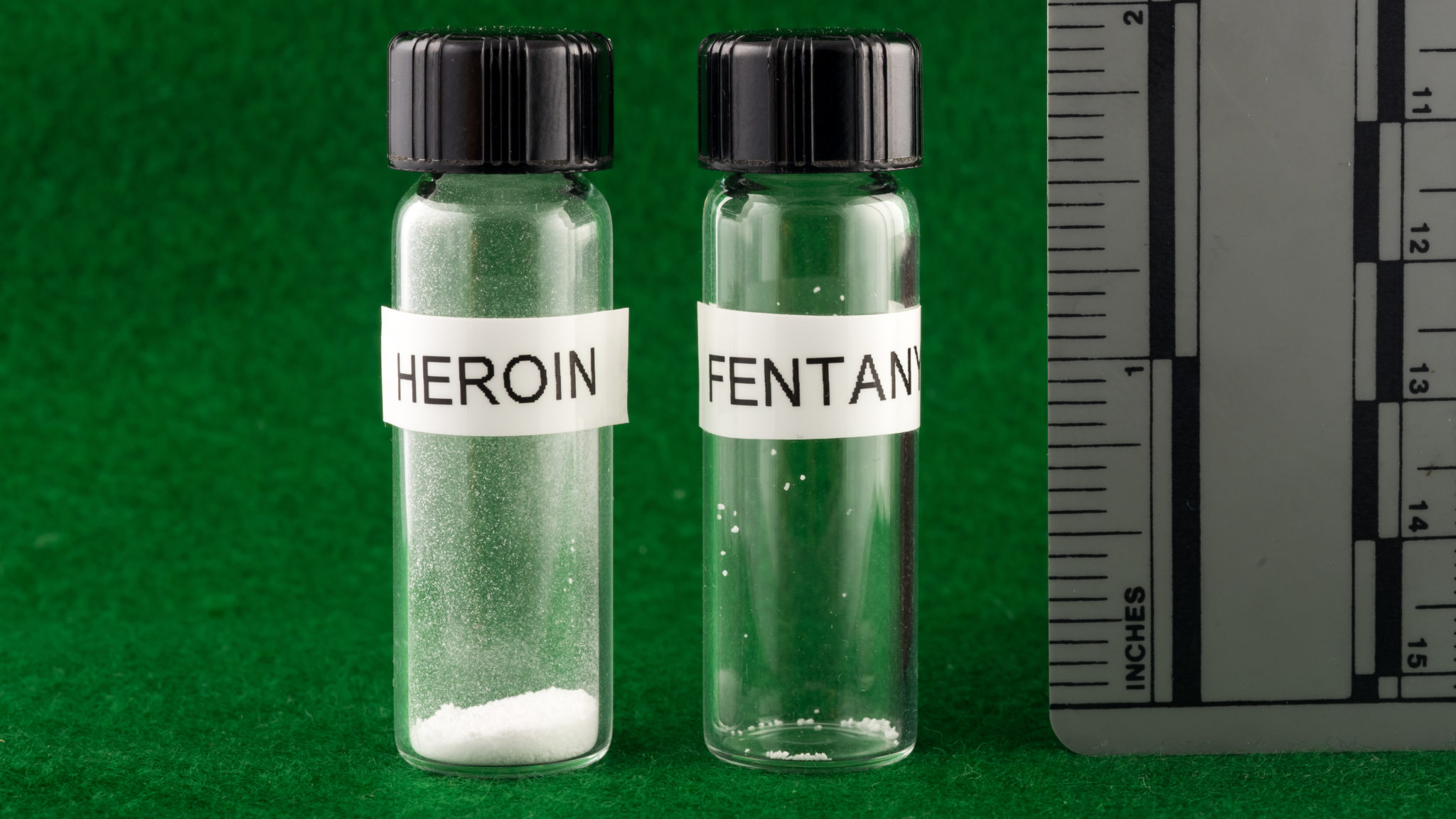The picture above shows the difference between a lethal dose of Heroin compared to that of Fentanyl.
What is Fentanyl?
Paul Janssen of Janssen Pharmaceuticals synthesized Fentanyl in 1960 under the name Sublimaze. It is a synthetic opioid reliever used as anesthesia to help prevent pain after surgery or other medical procedures. It is used to relieve chronic pain as well. Medical procedures and surgeons administer the drug intravenously for immediate effectiveness but for those with chronic pain, they apply Fentanyl through patches, lollipops or lozenges. Fentanyl is not intended for a pain that is mild or that lasts for a short period. Fentanyl is not very long-lasting, but it is fast acting and extremely powerful. It crosses the blood-brain barrier and binds to μ-opioid receptors quicker than other opioids. For this reason, it is about 50-100 times more potent than morphine and 25-50 times more potent than heroin. When used outside a hospital setting, Fentanyl can be extremely dangerous since the difference between a therapeutic and a deadly dose is minuscule. The lethal dose for an adult is about the size of three grains of sugar. Fentanyl is often mixed without the buyer’s knowledge with drugs like heroin and cocaine. By lacing their supply with Fentanyl, dealers can sell a more potent product with less expense. Many times buyers believe they are taking a typical dose of heroin only to overdose from a lethal dose of Fentanyl. Its unknown presence in prescription pills sold on the black market and its appearance as a deadly cocktail with heroin is the cause of the new wave of drug ODs in America. In the US, Fentanyl caused 20,100 deaths in 2016, a rise of 540% over the past three years. Contact us today to learn about our Fentanyl rehab program.
Symptoms and side effects
Fentanyl, like other opioids, works in the brain to change how your body feels and responds to pain. This reaction leads to feelings of drowsiness, lethargy and mellowness and euphoria and these feelings of happiness and analgesia are the motives for abuse. Fentanyl slows down the body’s breathing and heartbeat. When too much of the drug is used, a total suppression or OD takes place.
Negative side effects include:
- Dizziness and lightheadedness
- Dry mouth
- Retention of urine
- Sweating
- Severe constipation
- Difficulty seeing
- Nausea and vomiting
- Loss of appetite
- Shaking
- Itching or hives
- Suppression of breathing
- Bad dreams
- Weight loss
- Hallucinations
- Swollen extremities
- Depression
- Difficulty sleeping
- A headache
Signs of Overdose
- First Stage
- Pinpoint pupils.
- Weak muscles.
- Dizziness
- Confusion.
- Extreme sleepiness.
- Second Stage
- Bluish tint to nails and lips.
- Profoundly slowed heartbeat.
- Dangerously slowed or stopped breathing.
- Loss of consciousness.
- Very low blood pressure.
What is happening?
When the DEA tracks the origin of Fentanyl, they usually find the majority of product comes from the cartels of Mexico who smuggle it through the border. Mexican cartels have found Fentanyl to be cheaper and easier to produce than heroin. Individuals can also buy Fentanyl on the dark web and obtain a delivered package from China straight to their doorstep. This illicit narcotic has sent ripples through our nation. The drug has become so threatening, first-responders are now changing how they perform their job. Law enforcement now require officers to wear hazmat suits during raids. Fentanyl can be absorbed by skin contact and just a granular amount can be fatal. Along with safety measures, major US cities now require police and EMTs to carry Naloxone or Narcan (brand name). Naloxone has been very useful in reversing the effects of opioid overdoses, but Fentanyl significantly reduces its effectiveness – due to its naturally high potency and rapid effectiveness. As the opioid epidemic continues to rise and become a convoluted problem to our country, it is important to understand the main attributes of these problems. Fentanyl is the largest factor is the rise of opioid overdose in recent years. Unfortunately, this number will continue to rise unless there is a push for more advocacy and education about the dangers of this drug.
Government Action
Legal force against the entry of this drug is an inefficient allocation of government funds. Despite how much effort we put towards stopping these drugs from entering our country, it will never be enough. Harsher punishment for possession is a better start. Certain states, such as Louisiana, Kentucky, Maryland and Florida, have cracked down on Fentanyl by creating harsh punishments for possession – up to a minimum of15-years. Florida, Maryland, and Massachusetts have also passed laws allowing prosecutors to charge individuals who sell heroin, fentanyl, or carfentanil that leads to a fatal overdose, with first-degree murder. Apart from preventative measures, we also need to help individuals currently addicted – whether government-funded treatment centers or creating a healthcare package that makes treatment affordable. Without these systems, in place, there will be a continuing rise in opioid deaths. Alongside helping those currently addicted, we need safer alternatives – whether those alternatives be medicinal or therapeutic.







